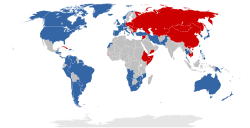Western Bloc
Appearance
This article needs additional citations for verification. (June 2014) |

First World: Countries aligned with the Western Bloc (i.e., NATO and allies), led by the United States
Second World: Countries aligned with the Eastern Bloc (i.e., Warsaw Pact, China, and allies), led by the Soviet Union

The Western Bloc, also known as the Free Bloc, Capitalist Bloc and the American Bloc, was a coalition of the countries that were allied with the United States (USA) and its ideology (liberalism), a member of NATO, opposed the Soviet Union and Warsaw Pact, and Anti-communism during the Cold War (1947-1991). The latter were referred to as the Eastern Bloc. The governments and the press of the Western Bloc were more inclined to refer to themselves as the Free World or the First World, whereas the Eastern Bloc was often called the "Communist World or Second World".
Western Bloc associations
NATO
 Belgium
Belgium Canada
Canada Denmark
Denmark France
France Germany (from 1990)
Germany (from 1990)
 West Germany (1955–1990)
West Germany (1955–1990)
 Greece (from 1952)
Greece (from 1952) Iceland
Iceland Italy
Italy Luxembourg
Luxembourg Netherlands
Netherlands Norway
Norway Portugal
Portugal Spain (from 1982)
Spain (from 1982) Turkey (from 1952)
Turkey (from 1952) United Kingdom
United Kingdom United States
United States
Countries which have become NATO members after the end of the Cold War
 Czech Republic (from 1999)
Czech Republic (from 1999) Hungary (from 1999)
Hungary (from 1999) Poland (from 1999)
Poland (from 1999) Bulgaria (from 2004)
Bulgaria (from 2004) Estonia (from 2004)
Estonia (from 2004) Latvia (from 2004)
Latvia (from 2004) Lithuania (from 2004)
Lithuania (from 2004) Romania (from 2004)
Romania (from 2004) Slovakia (from 2004)
Slovakia (from 2004) Slovenia (from 2004)
Slovenia (from 2004) Albania (from 2009)
Albania (from 2009) Croatia (from 2009)
Croatia (from 2009) Montenegro (from 2017)
Montenegro (from 2017) North Macedonia (from 2020)
North Macedonia (from 2020)
Other NATO-affiliated states and partners
ANZUS
Compact of Free Association
CENTO
Rio Treaty
 Argentina
Argentina Bahamas (from 1982)
Bahamas (from 1982) Bolivia (until 2005)
Bolivia (until 2005) Brazil
Brazil Chile
Chile Colombia
Colombia Costa Rica
Costa Rica Cuba (until 1959)
Cuba (until 1959) Dominican Republic (until 1990)
Dominican Republic (until 1990) Ecuador (until 2012)
Ecuador (until 2012) El Salvador
El Salvador Guatemala
Guatemala Honduras
Honduras Mexico
Mexico Nicaragua (until 1979)
Nicaragua (until 1979) Panama
Panama Paraguay
Paraguay Peru
Peru Trinidad and Tobago (from 1967)
Trinidad and Tobago (from 1967) United States
United States Uruguay
Uruguay
SEATO

 Australia
Australia France (until 1965)
France (until 1965) Laos (until 1975)
Laos (until 1975) New Zealand
New Zealand Pakistan (until 1972)
Pakistan (until 1972) Philippines
Philippines South Vietnam (until 1975)
South Vietnam (until 1975) Thailand
Thailand United Kingdom
United Kingdom United States
United States
Middle East/North Africa Region
 Bahrain
Bahrain Egypt (from 1979)
Egypt (from 1979) Iran (until 1979)
Iran (until 1979) Iraq (until 1958)
Iraq (until 1958) Israel
Israel Jordan
Jordan Kuwait
Kuwait Lebanon
Lebanon Morocco
Morocco Oman
Oman Palestine (West Bank government, until 2019)
Palestine (West Bank government, until 2019) Qatar
Qatar Saudi Arabia
Saudi Arabia Somalia
Somalia Sudan
Sudan Syrian opposition
Syrian opposition Tunisia
Tunisia Turkey (until 2009)
Turkey (until 2009) United Arab Emirates
United Arab Emirates Yemen (Hadi government)
Yemen (Hadi government)
 North Yemen (1962–1990)
North Yemen (1962–1990)
East Asia
Western Bloc Associations Today
NATO
Other NATO affiliated states and partners
Africa and Middle Eastern Partners
Asia, South East Asian and Oceania Partners
Inter-American Partners
Quadrilateral Security Dialogue
See also
References
Sources
- Matloff, Maurice. Makers of Modern Strategy. Ed. Peter Paret. Princeton: Princeton UP, 1971. 702.
- Kissinger, Henry. Diplomacy. New York: Simon & Schuster, 1994. 447,454.
- Lewkowicz, Nicolas. The United States, the Soviet Union and the Geopolitical Implications of the Origins of the Cold War New York and London: Anthem Press, 2018.
